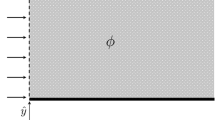Abstract
The flow past a three-dimensional obstacle on a flat plate is one of the key problems in the boundary-layer flows, which shows a significant value in industry applications. A direct numerical study of flow past a sphere above a flat plate is investigated. The immersed boundary (IB) method with multiple-direct forcing scheme is used to couple the solid sphere with fluid. The detail information of flow field and vortex structure is obtained. The velocity and pressure distributions are illuminated, and the recirculation region with the length of which is twice as much as the sphere diameter is observed in the downstream of the sphere. The effects of the sphere on the boundary layer are also explored, including the velocity defect, the turbulence intensity and the Reynolds stresses.
Access this chapter
Tax calculation will be finalised at checkout
Purchases are for personal use only
Preview
Unable to display preview. Download preview PDF.
Similar content being viewed by others
References
Schlichting, H.: Experimentelle Untersuchungen Zum Ranhigkeitsproblem. Ing. Arch. 7, 1–34 (1936)
Klemin, A., Schaefer, E.B., Beerer, J.G.: Aerodynamics of the Perisphere and Trylon at World’s Fair. Trans. Am. Soc. Civ. Eng. 2042, 1449–1472 (1939)
Okamoto, S.: Turbulent Shear Flow Behind a Sphere Placed On a Plane Boundary. Turbulent Shear Flows 2, 246–256 (1980)
Takayuki, T.: Flow Around a Sphere in a Plane Turbulent Boundary Layer. Journal of Wind Engineering and Industrial Aerodynamics 96, 779–792 (2008)
Zeng, L., Balachandar, S., Fischer, P.: Interactions of a Stationary Finite-Sized Particle with Wall Turbulence. Journal of Fluid Mechanics 594, 271–305 (2008)
Charles, S.: Peskin: Flow Patterns Around Heart Valves: A Numerical Method. Journal of Computational Physics 10, 252–271 (1972)
Goldstein, D., Handler, R., Sirovich, L.: Modeling a No-Slip Flow Boundary with an External Force Field. Journal of Computational Physics 105, 354–366 (1993)
Le, D.V., Khoo, B.C., Lim, K.M.: An Implicit-Forcing Immersed Boundary Method for Simulating Viscous Flows in Irregular Domains. Computer Methods in Applied Mechanics and Engineering 197, 2119–2130 (2008)
Mittal, R., Iaccarino, G.: Immersed Boundary Methods. Annu. Rev. Fluid Mech. 37, 239–261 (2005)
Mohd-Yusof, J.: Combined Immersed Boundaries/B-Splines Methods for Simulations of Flows in Complex Geometries. CTR Annual Research Briefs, 317–327 (1997)
Xu, S., Wang, Z.J.: A 3D Immersed Interface Method for Fluid–Solid Interaction. Computer Methods in Applied Mechanics and Engineering 197, 2068–2086 (2008)
Le, D.V., Khoo, B.C., Peraire, J.: An Immersed Interface Method for Viscous Incompressible Flows Involving Rigid and Flexible Boundaries. Journal of Computational Physics 220, 109–138 (2006)
Wang, Z., Fan, J., Luo, K.: Combined Multi-Direct Forcing and Immersed Boundary Method for Simulating Flows with Moving Particles. International Journal of Multiphase Flow 34, 283–302 (2008)
Luo, K., Jin, J., Zheng, Y.: Direct Numerical Simulation of Particle Dispersion in Gas-Solid Compressible Turbulent Jets. Chinese Journal of Chemical Engineering 13, 161–166 (2005)
Zhou, Z., Wang, Z.L., Fan, J.R.: Direct Numerical Simulation of the Transitional Bounda-ry-Layer Flow Induced by an Isolated Hemispherical Roughness Element. Comput. Methods Appl. Mech. Engrg. 199, 1573–1582 (2010)
Luo, K., Wang, Z., Fan, J.: Full-Scale Solutions to Particle-Laden Flows: Multidirect Forcing and Immersed Boundary Method. Physical Review E 76, 066709 (2007)
Wang, Z., Fan, J., Cen, K.: Immersed Boundary Method for the Simulation of 2D Viscous Flow Based On Vorticity–Velocity Formulations. Journal of Computational Physics 228, 1504–1520 (2009)
Wang, Z.L., Fan, J.R., Luo, K.: Immersed Boundary Method for the Simulation of Flows with Heat Transfer. International Journal of Heat and Mass Transfer 52, 4510–4518 (2009)
Luo, K., Zheng, Y.Q., Fan, J.R.: Interaction Between Large-Scale Vortex Structure and Dispersed Particles in a Three Dimensional Mixing Layer. Chinese Journal of Chemical Engineering 11, 377–382 (2003)
Wang, Z., Fan, J., Luo, K.: Numerical Study of Solid Particle Erosion On the Tubes Near the Side Walls in a Duct with Flow Past an Aligned Tube Bank. AIChE J. 56, 66–78 (2010)
Wang, Z.L., Fan, J.R., Luo, K.: Parallel Computing Strategy for the Simulation of Particulate Flows with Immersed Boundary Method. Science in China Series E: Technological Sciences 51, 1169–1176 (2008)
Peskin, C.S.: The Immersed Boundary Method. Acta Numerica 11, 479–517 (2002)
Griffith, B.E., Peskin, C.S.: On the Order of Accuracy of the Immersed Boundary Method: Higher Order Convergence Rates for Sufficiently Smooth Problems. Journal of Computational Physics 208, 75–105 (2005)
Uhlmann: An Immersed Boundary Method with Direct Forcing for the Simulation of Particulate Flows. Journal of Computational Physics 209, 448–476 (2005)
Musker, A.J.: Explicit Expression for the Smooth Wall Velocity Distribution in a Turbulent Boundary Layer. AIAA Journal 17, 655–657 (1979)
Orlanski, A.: Simple Boundary Condition for Unbounded Hyperbolic Flows. Journal of Computational Physics 21, 251–269 (1976)
Author information
Authors and Affiliations
Corresponding author
Editor information
Editors and Affiliations
Rights and permissions
Copyright information
© 2014 Springer International Publishing Switzerland
About this chapter
Cite this chapter
Zhao, H., Wei, A., Luo, K., Fan, J. (2014). Numerical Study of Turbulent Boundary-Layer Flow Induced by a Sphere Above a Flat Plate. In: Obaidat, M., Filipe, J., Kacprzyk, J., Pina, N. (eds) Simulation and Modeling Methodologies, Technologies and Applications. Advances in Intelligent Systems and Computing, vol 256. Springer, Cham. https://doi.org/10.1007/978-3-319-03581-9_8
Download citation
DOI: https://doi.org/10.1007/978-3-319-03581-9_8
Publisher Name: Springer, Cham
Print ISBN: 978-3-319-03580-2
Online ISBN: 978-3-319-03581-9
eBook Packages: EngineeringEngineering (R0)



